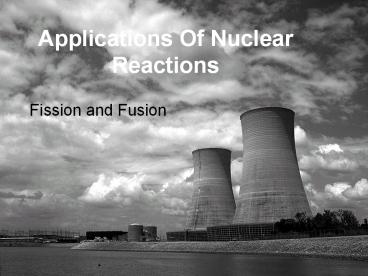Applications Of Nuclear Reactions - PowerPoint PPT Presentation
1 / 15
Title:
Applications Of Nuclear Reactions
Description:
Applications Of Nuclear Reactions Fission and Fusion Atomic Fission Nuclear fission occurs when a heavy nucleus such as U-235 splits into two smaller nuclei. – PowerPoint PPT presentation
Number of Views:200
Avg rating:3.0/5.0
Title: Applications Of Nuclear Reactions
1
Applications Of Nuclear Reactions
- Fission and Fusion
2
Atomic Fission
- Nuclear fission occurs when a heavy nucleus such
as U-235 splits into two smaller nuclei. - The total rest mass of the products is less than
the original rest mass. - The mass difference is converted to the energy
released using emc2 - This process occurs naturally at a slow rate, but
can be accelerated by neutron bombardment in the
laboratory.
3
Neutron Bombardment of U-235
- U-235 absorbs a slow moving neutron.
- U-236 is unstable and lasts for only 10-12 s.
- The U-236 nucleus splits into two fragments and
emits several neutrons.
4
Nuclear Fusion
- Lighter nuclei undergo a process called nuclear
fusion - Fusion takes a great amount of energy to be
initiated in order to overcome the proton-proton
barrier between nuclei. - However, a greater amount of energy is released
in the process. - Stars produce their energy through the fusion
process.
5
Fusion Process
- Hydrogen is fused together forming deuterium.
- He-3 is formed from hydrogen isotopes.
- He-4 is formed through 2 different processes.
- The energy is produced though the gamma,
neutrino, and positron emission.
6
Nuclear Power Plants USA
7
Nuclear Facts
- Nuclear energy is energy that is released either
by splitting atomic nuclei or by forcing the
nuclei of atoms together. - Nuclear energy comes from mass-to-energy
conversions that occur in the splitting of atoms.
- Nuclear energy is produced by a controlled
nuclear chain reaction and creates heatwhich is
used to boil water, produce steam, and drive a
steam turbine.
8
Nuclear Facts
- Nuclear power can come from the fission of
uranium, plutonium or thorium or the fusion of
hydrogen into helium. Today it is almost all
uranium. - Nuclear power plants need less fuel than ones
which burn fossil fuels. One ton of uranium
produces more energy than is produced by several
million tons of coal or several million barrels
of oil.
9
Nuclear Facts
- In France, nuclear power is the most widespread,
supplying 80 percent of the country's
electricity. - As of 2004, nuclear power provided 6.5 of the
world's energy and 15.7 of the world's
electricity, with the U.S., France, and Japan
together accounting for 57 of nuclear generated
electricity. - Nuclear energy (nuclear power) accounts for about
19 percent of the total electricity generated in
the United States.
10
Why Not?
11
Basic Components Nuclear Plant
12
Are You Exposed?
13
Yearly Dosage of Radiation
14
Limiting Exposure
15
Homework
- Pg 695-696 34-42






























